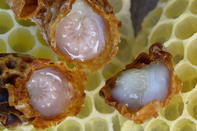Royal jelly, is a thick, white substance, made in the mouth and throat glands (sometimes called the ‘brood food’ glands) of worker bees. It is a complex mixture of different nutritional ingredients.

It consists of water (50% - 60%), proteins (18%), carbohydrates (15%), fats (3% - 6%), mineral salts (1.5%) - including potassium, calcium, sodium, iron and manganese - as well as vitamins. Royal jelly is also known as a ‘superfood’ and is fed to the queen bee and to the newly hatched bee larvae (for two to three days only).
This ‘superfood’ is the main reason for the longevity of the queen bee compared to the other bees: queen bees live up to 40 times longer than worker bees. All larvae are fed with royal jelly for the first few days after hatching, but worker larvae are then fed ‘bee bread’, a fermented mix of royal jelly, honey and pollen.
A few select larvae continue to be fed on royal jelly, which allows them to change into queen bees - the large, long-living egg-laying member of the bees’ social order.
There is a special active compound, royalactin, in royal jelly, which transforms larvae into queens. Some studies doubt this and suggest that not feeding the ‘queen larvae’ the normal diet of bee bread, in fact, allows their development of queen bee characteristics. Royal jelly is not stored and is fed directly to the queen and larvae.
Production of Royal Jelly
Since the 1990s, the income of Chinese beekeepers has been increasing year by year due to a large increase in the production of royal jelly. These beekeepers make good profits with an average of 5 kg of royal jelly harvested (per colony a year), while some beekeepers have poor profits with an average below 2 kg of royal jelly per colony a year.
Royal jelly is harvested by manually removing one to three day old bee larvae from the brood cells and then removing the royal jelly with a pipet or small spatula. Royal jelly should be refrigerated to between 0 - 5℃ within hours of harvesting and stored in dark glass containers.
The shelf life is about 18 months for refrigerated royal jelly products and 24 months for frozen products. Freeze-dried royal jelly can be kept for years. According to Mike Allsopp, head researcher at the Honeybee Research Section of the Agricultural Research Council (ARC) in Stellenbosch, royal jelly is not produced commercially in South Africa.
‘It is practically impossible to produce commercial levels of royal jelly in Cape honeybees (Apis mellifera capensis) because of the nature of the bees. A beekeeper would just get egg-laying worker colonies, which would end up in empty boxes.
Trying to produce royal jelly in areas where the African bee (Apis mellifera scutellata) is farmed will worsen the ‘Capensis problem’ which can lead to the destruction of colonies. (The Capensis problem is when the Cape bees take over the hives and colonies of African bees, with the result of killing the African bee queen and her colony.)
Uses of Royal Jelly
Apart from providing the protein-rich food for the potential queen larvae, royal jelly is harvested by man to be used in medicinal and cosmetic applications.
Used fresh, cooled or frozen and freeze-dried, royal jelly can be mixed into food, used in tablet or liquid form as an injection or made into skin creams for burn wounds. It has also been fed to racehorses and to breed mites and insects.
Royal jelly imported into South Africa (for use in locally-made products) is irradiated. This can potentially destroy beneficial properties.
By Marinda Louw